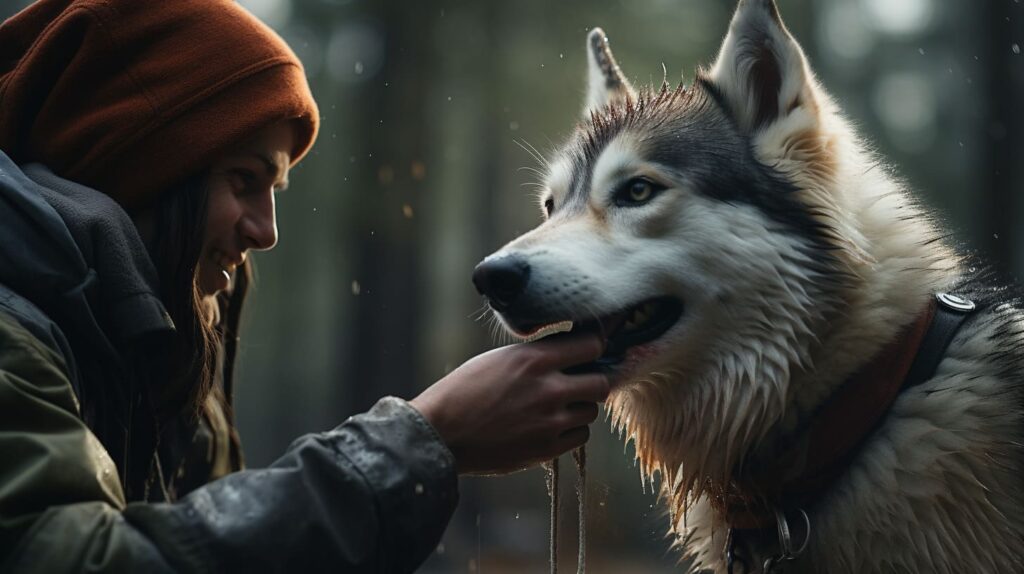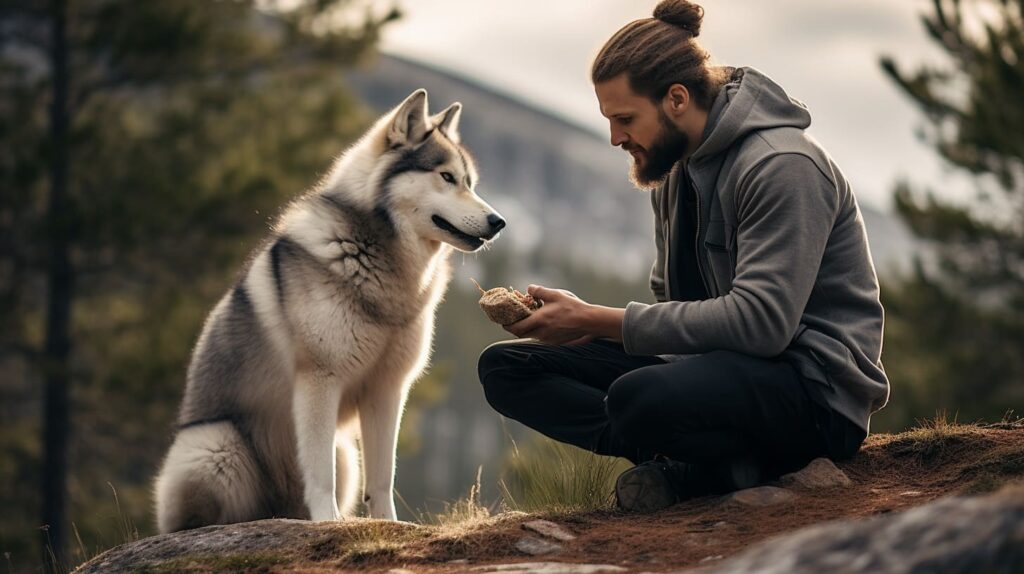Training a Husky can sometimes feel like trying to convince a stubborn snowball to avoid the sun. However, with the right approach, it can become a rewarding journey filled with fun, laughter, and a lot of “aha!” moments. One such magical key to unlock a harmonious training journey is positive reinforcement. It’s a training method that not only nurtures a bond of trust and understanding between you and your Husky but also makes learning an enjoyable experience for your furry friend. This article will trot you through the concept of positive reinforcement with husky training, why it’s a Husky’s best friend, and how to implement it in your training sessions. So, brace yourself for a fun, fur-filled learning expedition!
Understanding Positive Reinforcement
Positive reinforcement is the dog-training equivalent of getting a gold star each time you ace a test. It’s about rewarding your Husky with praise, treats, or toys whenever they perform a desired behavior. The idea is to encourage them to repeat the good behavior by associating it with positive outcomes.
The benefits of positive reinforcement are as vast as a Husky’s love for snow. It fosters a happy learning environment, making training sessions something your Husky looks forward to rather than dreading. This method also promotes trust and strengthens the bond between you and your furry companion, essential for successful training.
The science behind positive reinforcement lies in the psychology of behavior conditioning, which posits that rewarded behaviors are likely to be repeated. It’s the kinder, gentler way of training that respects your Husky’s intelligence and independent spirit rather than trying to dominate or control them. Besides, who could resist the sight of a happy, wagging Husky tail each time they get it right? Positive reinforcement is not just about training; it’s about building a language of love, understanding, and respect with your Husky. So, are you ready to speak Husky?

Why Positive Reinforcement Works for Huskies
Huskies are known for their independent and free-spirited temperament, much like the icy wilderness they hail from. They’re intelligent, quick learners but also have a streak of independence that can sometimes be mistaken for stubbornness. This is where positive reinforcement comes into play, like a gentle snowflake landing on a snowy landscape.
Positive reinforcement acknowledges the independent spirit of Huskies while guiding them gently toward desired behaviors. Unlike harsh training methods, positive reinforcement does not break the Husky’s heart or create fear. Instead, it builds a bond of trust and understanding essential for effective communication.
Huskies thrive on positive interactions and social engagements. They are more likely to participate willingly when they associate training with fun and rewards. Imagine telling your Husky, “Hey buddy, every time you sit on command, there’s a tasty treat coming your way!” Your Husky will be all ears and paws, ready to dive into the training session.
Moreover, positive reinforcement allows your Husky to express their intelligence and creativity. It’s like giving them a canvas to paint their understanding while you guide their paws (in a manner of speaking). Over time, Huskies trained with positive reinforcement develop a love for learning and exhibit high trust towards their human companions.
Examples of successful training sessions using positive reinforcement are plentiful. From Huskies learning basic commands like sit, stay, and down, to performing complex tricks or participating in dog sports, the sky’s the limit when the learning environment is positive and encouraging.
In essence, positive reinforcement is like having a friendly snowball fight with your Husky; it’s fun, engaging, and builds a strong bond. And the best part? You both come out winners, frolicking in the snow of mutual respect and understanding!
Implementing Positive Reinforcement
Training a Husky with positive reinforcement is like setting out on a jolly sled ride together. With the right steps and a dash of patience, you’ll glide smoothly over the snowy terrain of training challenges. Here’s how to kickstart your positive reinforcement journey:
Step-by-step Guide
- Start with Basic Commands: Begin with simple commands like sit, stay, or come. Reward your Husky immediately whenever they follow the command. It’s like giving them a little cheer for every tiny victory!
- Use Treats, Praise, or Toys as Rewards: Discover what makes your Husky’s tail wag—be it tasty treats, affectionate praise, or their favorite squeaky toy. Use these rewards to reinforce desired behaviors.
- Keep Training Sessions Short and Sweet: Huskies have a relatively short attention span. It’s ideal to keep training sessions short, fun, and positive. Aim for about 5 to 10 minutes for puppy Huskies and up to 15 minutes for adults.
- Be Consistent with Commands and Rewards: Consistency is key. Use the same commands and reward system to avoid confusing your Husky. It’s like learning a dance together, step by step, till you both glide in harmony.
- Avoid Punishments: Shouting or physical punishments can scare your Husky and create a fearful association with training. Stick to the positive vibes only!
Essential Tools and Aids
- Treats: Have a stash of yummy treats ready to reward your Husky. Choose healthy options that won’t interfere with their diet.
- Clicker: A clicker can be a useful tool to mark the exact moment your Husky performs the desired behavior. It’s like a little applause for their performance!
- Training Pouch: Keep a training pouch handy to carry treats and toys. It helps to have rewards readily accessible to keep the training momentum going.
Common Commands and Tricks
- Basic Commands: Start with basic commands like sit, stay, come, and down.
- Advanced Tricks: Once your Husky masters the basics, venture into teaching tricks like paw, roll over, or even fetching. Remember, the sky (or shall we say the snow?) is the limit!
By following these steps and using the right tools, you’ll find that training your Husky is not an arduous task but a delightful bonding experience. So, gear up and let the fun training sled ride begin!
Training Sessions: What to Expect
Venturing into the world of training with your Husky is akin to embarking on a thrilling yet unpredictable sled ride across the snowy wilderness. Each day brings its own set of challenges and rewards. Here’s a glimpse of what to expect in your training sessions.
Setting Realistic Expectations
Training a Husky requires a blend of realistic expectations, a dash of patience, and a sprinkle of humor. Understanding that progress may be slow and sometimes non-linear is crucial. Some days, your Husky might grasp a command instantly, while other days, they might be more interested in chasing their tail. And that’s okay! The journey is all about celebrating small wins and learning together.
Common Challenges
- Distractions: Huskies are curious creatures. A fluttering butterfly or a rolling snowball could easily divert their attention. Training in a quiet, distraction-free environment, especially initially, can be beneficial.
- Stubbornness: Huskies are known for their independent nature. There might be times when they’d prefer exploring the yard over a training session. It’s essential to remain patient and keep the training vibes positive.
- Boredom: Repeating the same command over and over can bore your Husky. Keep the training sessions engaging by introducing new commands or changing the environment.
Celebrating Small Victories
Every sit, stay, or paw your Husky offers is a small victory, a step towards becoming a well-behaved companion. Celebrate these moments with loads of praise, treats, and belly rubs. Your enthusiastic reactions will encourage your Husky to engage more in the training sessions.
Progress, No Matter How Slow
Some Huskies might take longer to train than others, and that’s perfectly fine. The aim is to keep moving forward, no matter the pace. Every training session is a learning experience, an opportunity to understand your Husky better, and a step towards a well-behaved, happy furry companion.
In the whimsical world of Husky training, every day is a new adventure. Set your expectations, gear up to face the challenges, celebrate the small victories, and remember, slow and steady wins the race!
Consistency and Patience in Training
Just like a sled needs a consistent path to glide smoothly, training a Husky requires a steady dose of consistency and patience. These two elements are the magical snowflakes that can turn your training journey into a joyful expedition rather than a frosty ordeal. Let’s delve into why they are crucial and how to embody them in your training regime.
The Importance of Being Consistent
Consistency in commands, rewards, and training sessions establishes a clear communication channel between you and your Husky. When the same command leads to the same result, your Husky starts understanding what’s expected of them. It’s like having a steady beat to dance to, making the steps clearer and easier to follow.
- Same Commands: Stick to the same words for each command. If “sit” is the cue for sitting, ensure everyone in the family uses the same term.
- Regular Training Sessions: Consistent training sessions reinforce the learning and keep the momentum going. A little practice every day is better than a marathon session once a week.
- Uniform Reward System: Maintain a uniform system of rewards. If a click followed by a treat marks a correct behavior, keep it that way throughout.
Patience: Your Companion on This Journey
Huskies are intelligent, but their independent nature can sometimes stretch your patience. Remember, every Husky has its own pace of learning. Some days might feel like you are trying to teach a snowball to sit, but patience will thaw the icy moments, leading to eventual success.
- Understanding the Learning Curve: Every new command is a challenge for your Husky. Understand their learning curve and celebrate the small milestones along the way.
- Stay Calm and Positive: It’s easy to get frustrated, but maintaining a calm demeanor encourages a positive training environment. Your Husky can sense your emotions; a relaxed, patient attitude will reflect in their behavior too.
Combining consistency with patience creates a nurturing environment for your Husky to learn and grow. It’s like building a snowman; no matter how small, each snowball contributes to creating a masterpiece. So, embrace these two virtues, and you’ll witness the beautiful journey of your Husky blossoming into a well-behaved, loving companion.
Tips and Tricks for Positive Reinforcement in Husky Training
| Tip | Description |
|---|---|
| 1. Start Early | Begin training your Husky puppy as soon as you bring them home. Early exposure to positive reinforcement is key. |
| 2. Use High-Value Treats | Select treats that your Husky finds extremely enticing. These treats will serve as powerful rewards for good behavior. |
| 3. Keep Training Sessions Short | Huskies have shorter attention spans, so keep training sessions brief and engaging to prevent boredom. |
| 4. Consistency is Key | Be consistent with your commands and rewards to avoid confusion. Use the same cues for desired behaviors every time. |
| 5. Be Patient and Calm | Maintain a calm and patient demeanor during training. Huskies respond better to positive reinforcement in a relaxed setting. |
| 6. Praise and Affection | Along with treats, shower your Husky with praise, petting, and affection when they follow commands correctly. |
| 7. Capture Good Behavior | Whenever you see your Husky displaying good behavior naturally, reward them immediately to reinforce that behavior. |
| 8. Ignore Undesirable Behavior | Avoid reacting to undesirable behavior with punishment. Instead, ignore it and redirect your Husky towards positive actions. |
| 9. Clicker Training | Consider using a clicker to mark desired behaviors precisely. This adds clarity to your Husky’s understanding of commands. |
| 10. Stay Consistent with Everyone | Ensure that everyone in your household follows the same training methods and cues to avoid confusion for your Husky. |
These tips will help you effectively utilize positive reinforcement in training your Husky, building a strong bond and encouraging good behavior.
Snout Summaries
Embarking on the training journey with your Husky can initially feel like trying to catch snowflakes during a storm, elusive yet exhilarating. Positive reinforcement emerges as a gleaming snowflake amidst the flurry, offering a gentle, rewarding, and effective approach to training your Husky. It’s the method that celebrates the unique temperament of Huskies, nurturing a bond of love, trust, and mutual respect.
The essence of positive reinforcement is simple yet profound: reward the behaviors you want to see more of. It’s about cherishing the tiny victories, the small steps your Husky takes towards mastering a command. It’s not just a training philosophy but a way of building a lifelong companionship filled with understanding and communication.
Incorporating consistency and patience in your training regime lays down a smooth path for your Husky to trot along. It’s about speaking the same language and dancing to the same tune, building a rhythm that both you and your Husky find easy to groove to.
The challenges faced during training sessions are but mere snow bumps along the journey. Each challenge provides a learning experience, an opportunity to understand your Husky better, and a step towards creating a well-behaved, happy, and healthy companion.
In the whimsical world of Husky training, every day is a new adventure, filled with laughter, learning, and lots of wagging tails. So, as you step into this exciting expedition, remember to pack a bag full of patience, a dash of consistency, and a heart full of love and understanding. Happy training!






